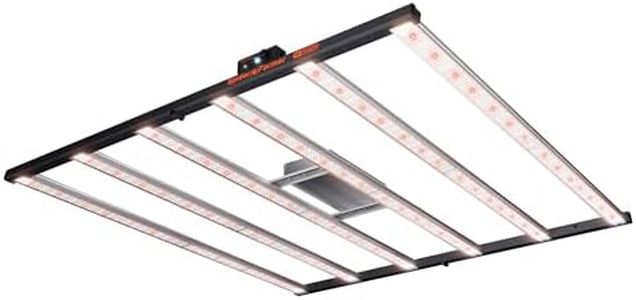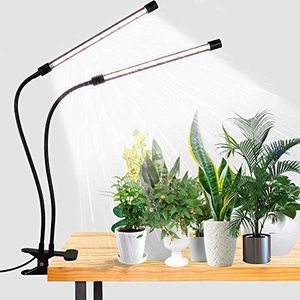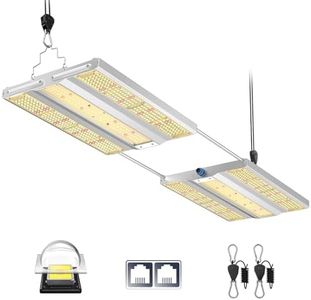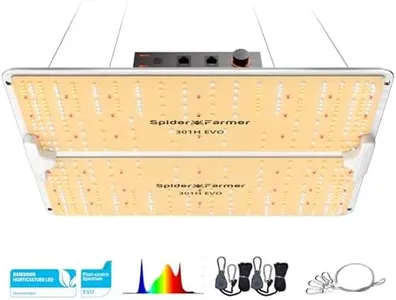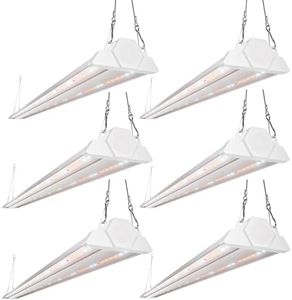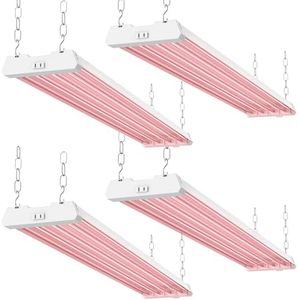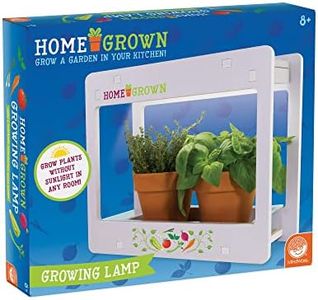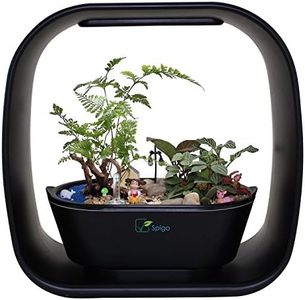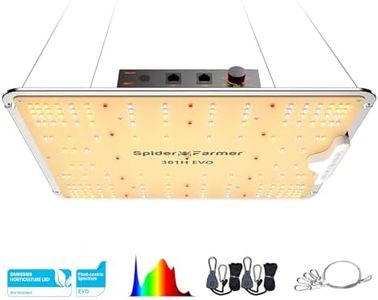10 Best Tomato Grow Lights 2025 in the United States
Our technology thoroughly searches through the online shopping world, reviewing hundreds of sites. We then process and analyze this information, updating in real-time to bring you the latest top-rated products. This way, you always get the best and most current options available.

Our Top Picks
Winner
Spider Farmer G8600 Cost-Effective 800W LED Grow Lights, 4x4ft/5x5ft Coverage Commercial Bar Style LED Grow Lamp for Indoor Plants Vertical Farming, 2025 Upgraded Smart App Control
Most important from
328 reviews
The Spider Farmer G8600 is an 800W LED grow light designed to support indoor plant growth, making it a suitable choice for both commercial and personal tomato growers. One of its key strengths is its high efficiency, delivering a strong light output (PPE of 2.85 μmol/J) and uniform light distribution over a 4x4 or 5x5 ft area. This ensures that your tomato plants receive adequate light for optimal growth. Additionally, the light is dimmable and features a digital display, which makes it easy to adjust the brightness according to different growth stages.
The foldable, plug-and-play design adds convenience, especially for those who may find installation challenging. Another major advantage is the 5-year warranty, offering peace of mind with long-term support and reliability. The Spider Farmer App provides smart control, allowing users to manage light schedules and brightness remotely, enhancing convenience and control over the growing environment.
However, at 27.6 pounds, the light is relatively heavy, which may pose some installation challenges for individuals. Additionally, while it is energy efficient for its power output, the 800W consumption might still be high for those looking to minimize energy usage. Despite these considerations, the Spider Farmer G8600 is a robust and user-friendly option for boosting tomato growth indoors.
Most important from
328 reviews
GooingTop LED Grow Light,6000K Full Spectrum Clip Plant Growing Lamp with White Red LEDs for Indoor Plants,5-Level Dimmable,Auto On Off Timing 4 8 12Hrs
Most important from
22918 reviews
The GooingTop LED Grow Light offers a 6000K full-spectrum white light equipped with 10 red and 74 white LEDs, which closely mimics natural sunlight. This light spectrum is ideal for indoor plants, including tomatoes, providing them with the necessary light for photosynthesis. The product features a high color rendering index of 95, making the light soft and flicker-free, which is also suitable for use as a reading lamp.
The light intensity is adjustable with 5 dimmable levels, allowing you to customize the brightness based on your plants' needs. The timer function is a convenient feature, offering 4, 8, and 12-hour settings that operate on a 24-hour cycle, ensuring your plants get consistent lighting without manual intervention. The flexible gooseneck and strong clamp make it easy to position the light for optimal coverage, though it might be limited to smaller areas given the compact design.
Energy efficiency is a notable strength, as the lamp consumes only about 10 watts of power, making it cost-effective to run at approximately $2 per month if used for 12 hours a day. However, the heat output is low, which is generally beneficial to avoid overheating but might not be sufficient for larger plants in colder environments. The lifespan is backed by a 365-day warranty, indicating reliable durability. This grow light is best suited for small house plants or tabletop pots and offers a flexible solution for indoor gardeners. The product’s versatility and efficiency make it a practical choice for those growing tomatoes and other indoor plants, though it may not be suitable for larger gardening setups due to its limited coverage area.
Most important from
22918 reviews
MARS HYDRO 2025 New Version FC-E4800 Foldable LED Grow Light 4x4ft Full Spectrum Grow Light Bar 480Watt Plant Growing Light Remote Control
Most important from
1371 reviews
The MARS HYDRO 2025 New Version FC-E4800 Foldable LED Grow Light is a sophisticated piece of equipment designed for both personal and commercial horticulture. This model comes with a full spectrum of light, making it suitable for all stages of tomato growth. With 2052 BridgeLux diodes and a high efficiency of 2.8 µmol/J, it promises a high yield of up to 2.5 grams per watt, making it a cost-effective option for serious growers.
The coverage area is 4x4 feet for personal use and 3x3 feet for commercial purposes, making it versatile for different growing setups. The foldable design saves time on installation, and the integrated dimmable feature allows for precise control over light intensity, which is particularly useful for different growth stages. Additionally, the light has a robust aluminum heatsink and six slim profile passive cooled bars for superior heat dissipation, ensuring that your growing space remains at an optimal temperature and reducing electricity costs by about 50% compared to HID lights.
The need to order the iConnectu Controller separately is a bit inconvenient and can add to the cost. The light intensity and coverage are solid, but the remote control might not have the same intuitive control for all users. While it is waterproof and offers daisy-chaining capabilities for up to 20 lights, it might be excessive for small-scale home growers. This grow light is best suited for those who have a serious interest in growing tomatoes either at a commercial level or with a highly efficient personal setup.
Most important from
1371 reviews
Buying Guide for the Best Tomato Grow Lights
Choosing the right grow lights for your tomatoes is crucial for ensuring healthy growth and a bountiful harvest. Grow lights provide the necessary light spectrum that tomatoes need for photosynthesis, especially if you're growing them indoors or in a greenhouse where natural sunlight is limited. When selecting grow lights, consider the type of light, its intensity, coverage area, and energy efficiency. Understanding these key specifications will help you make an informed decision that suits your growing needs and environment.FAQ
Most Popular Categories Right Now


